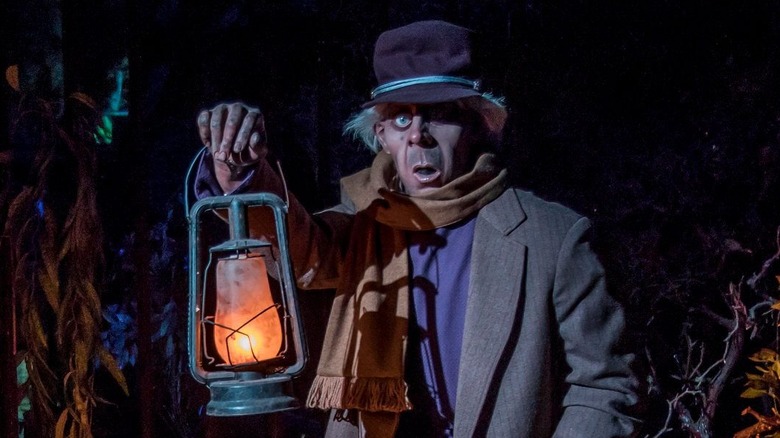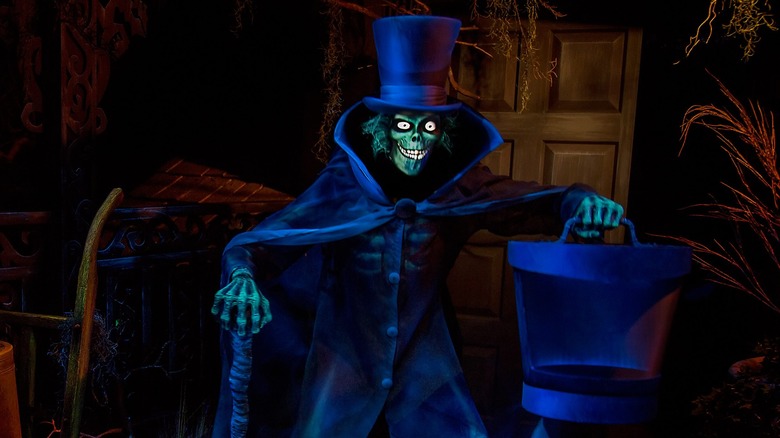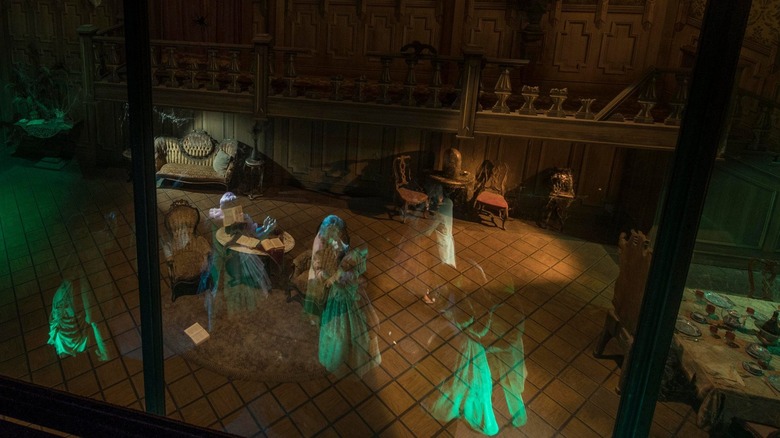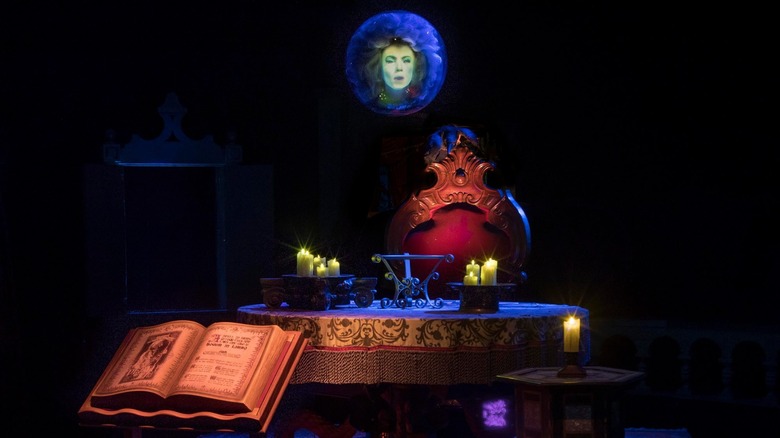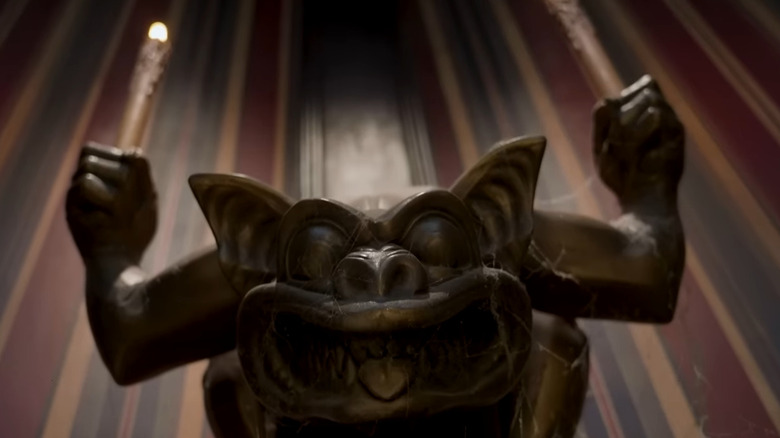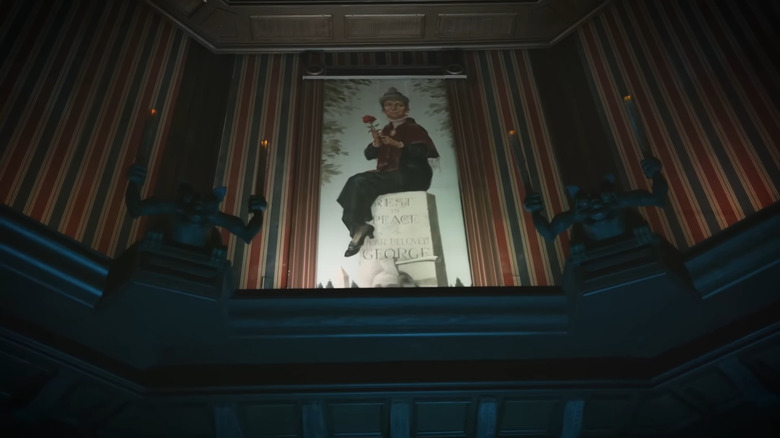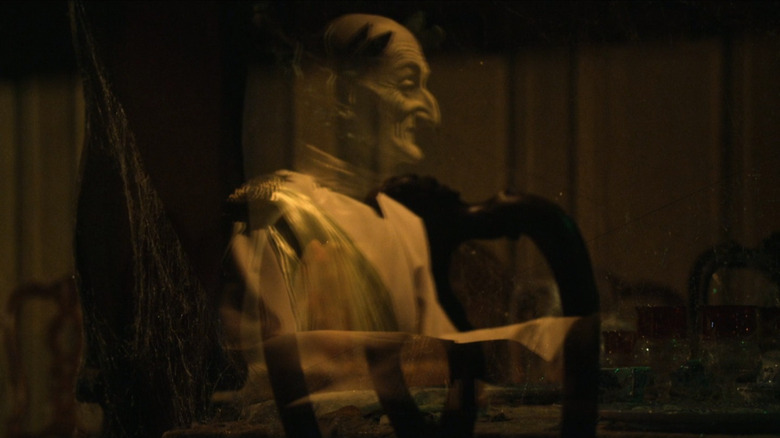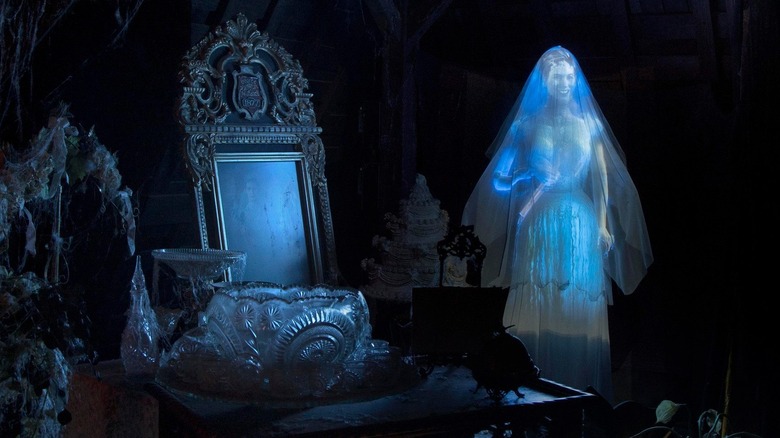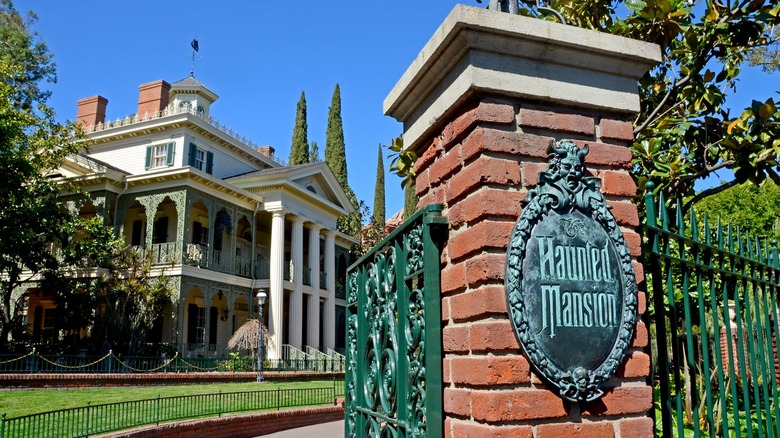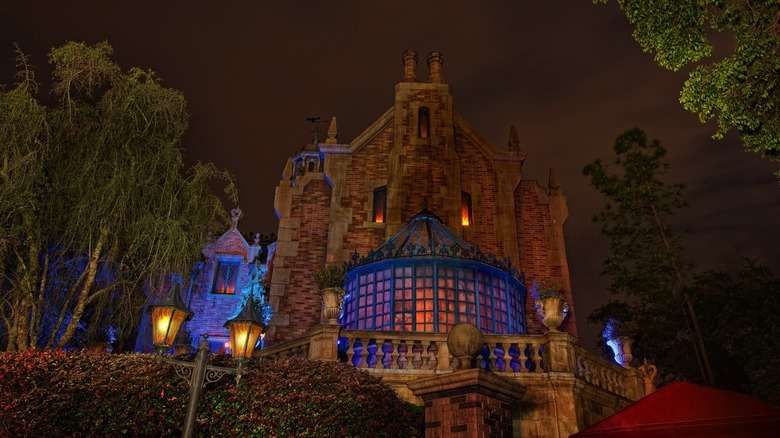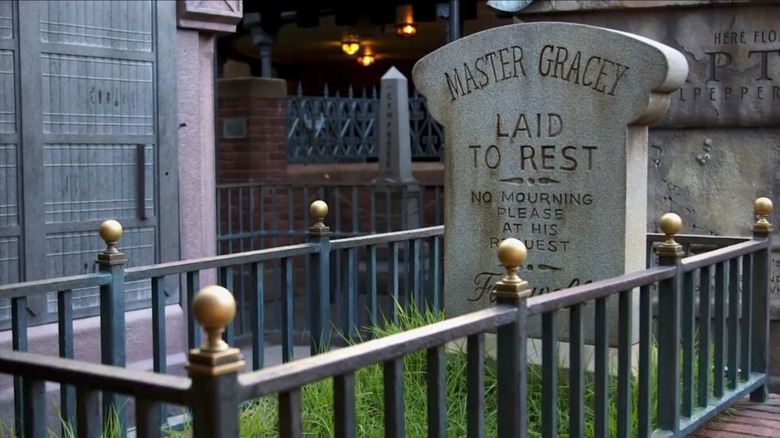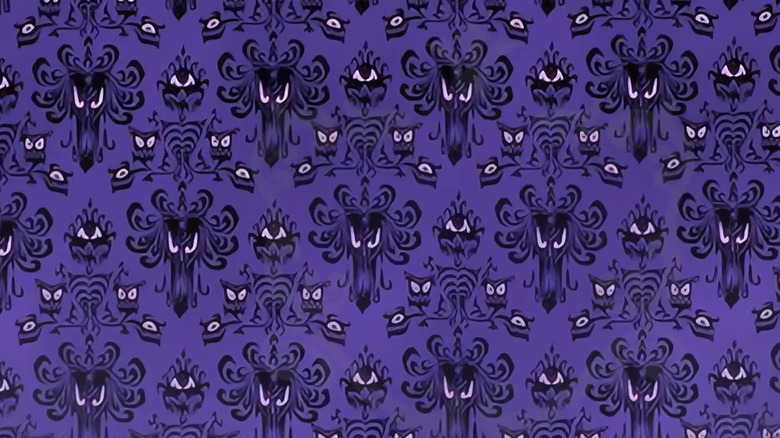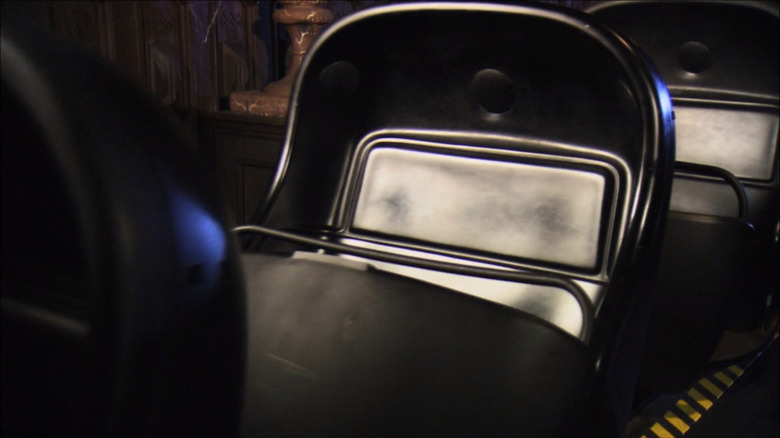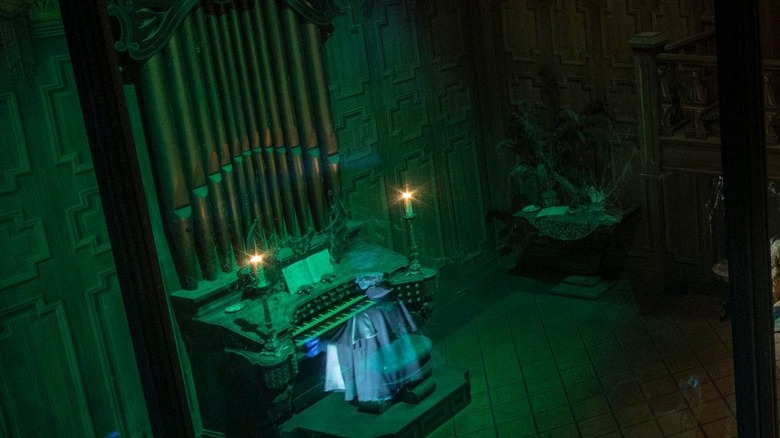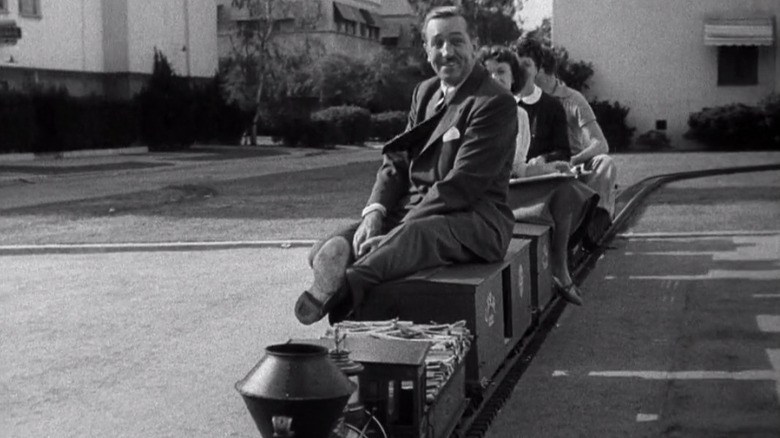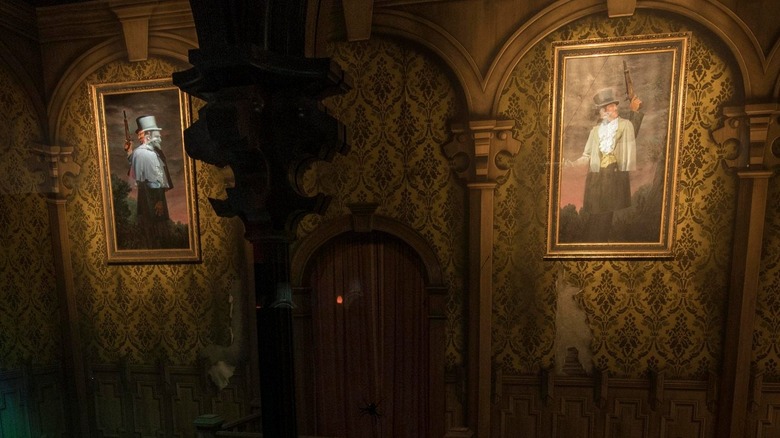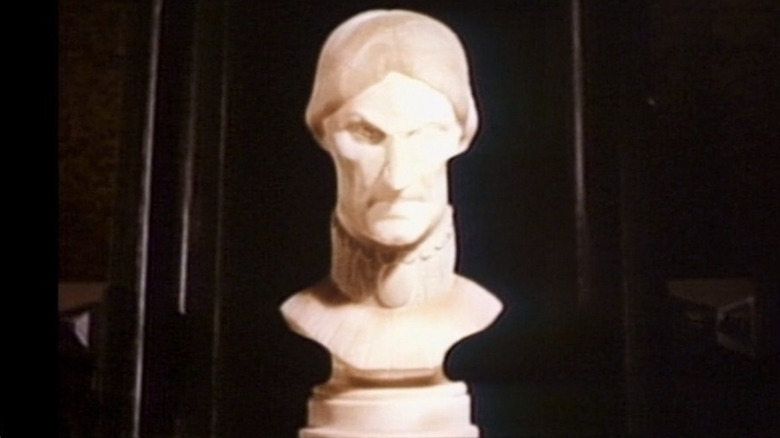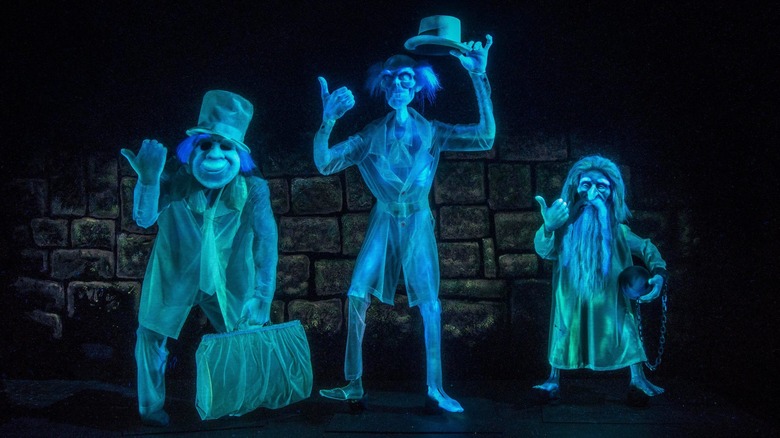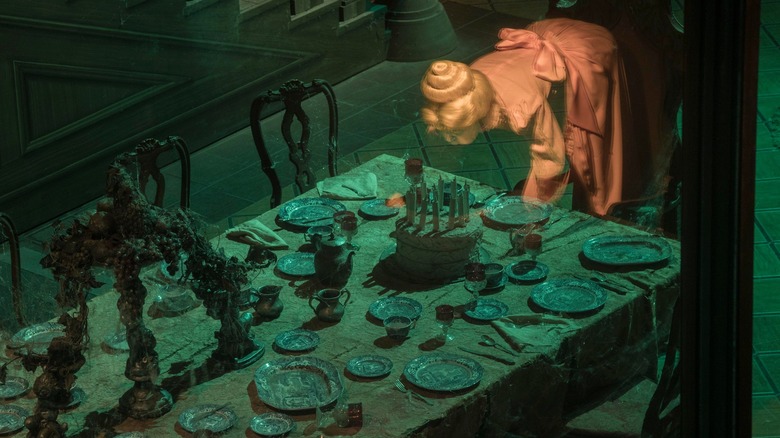18 Haunted Mansion Easter Eggs Straight Out Of The Disney Ride
Disney's 2023 "Haunted Mansion" movie boasts 999 ghosts — and nearly that many Easter eggs paying tribute to its source material. Disney first opened the Haunted Mansion theme park attraction in 1969 at Disneyland in California. The ride, which isn't based on any existing Disney story, slowly transports guests through a stately home occupied by hundreds of "happy haunts," as the narrator calls the ghosts who reside there.
Disney artists combined cutting-edge Audio-Animatronics technology, ingenious special effects, and superb music to create what many regard as the greatest theme park attraction of all time. Other versions of Haunted Mansion, some nearly identical to the original and others completely different, opened later at Walt Disney World, Tokyo Disneyland, Disneyland Paris, and Hong Kong Disneyland.
The intellectual property's storied legacy gave director Justin Simien and writer Katie Dippold a lot to work with when bringing their new adaptation to the silver screen. A clean slate from Disney's 2003 "Haunted Mansion" movie starring Eddie Murphy, this "Haunted Mansion" brims with hidden references to the classic Disneyland spectacle and the people who brought it to life. Some of these Easter eggs are in plain sight, as not-so-hidden story elements with untold real-life lore. Other details require a sharper eye. Whether you've ridden the attraction 999 times or you just learned that Disney based the movie on a ride, here are 18 Haunted Mansion Easter eggs straight out of Disneyland.
Spoilers ahead.
The Hatbox Ghost
Alistair Crump, known in his afterlife as the Hatbox Ghost (Jared Leto), stands front and center as the primary antagonist of the film, but the character's existence began as an obscure anecdote in Disney history. The Hatbox Ghost, whose head disappears from its body and then reappears in a hatbox, debuted with the original Disneyland ride in 1969. Just one week later, Yale Gracey, who designed special effects for the attraction, removed the Hatbox Ghost because the disappearing/reappearing head didn't look believable.
Ever since, the Hatbox Ghost became the stuff of Disney legend. Why? For being part of such a renowned fixture of pop culture as Haunted Mansion, but only residing there for one week, and then gaining a huge following among fandoms. More than four decades after Gracey's dilemma, special effects artist Daniel Joseph devised a solution. In 2015, the Hatbox Ghost returned to Disneyland — this time his beheading fully operational — to dazzling results. By the end of 2023, the Hatbox Ghost will make his debut in Walt Disney World's version of the ride.
Creativity behind the camera
Throughout "Haunted Mansion," director Justin Simien coyly guides the camera in ways that mirror the riders' viewpoints onboard the attraction. In one scene, Ben (LaKeith Stanfield) walks down a long, dimly lit hallway. As he does, a side-profile tracking shot follows the actor from right to left. It's a unique angle not often used in films — and brings to mind the experience of traversing a nearly identical hallway, slowly clunking along from right to left, in the ride.
Elsewhere, the camera looks upon the home's dining room/ballroom. The space itself is somewhat of an Easter egg of its own, resembling the ride's blueprints to a tee. In the attraction, the dining room is home to a memorable sequence featuring waltzing ghosts that riders view from an elevated platform. They look down at the action rather than gaze upon it at eye level. Simien utilizes this same perspective on more than one occasion when guiding the audience's eyes toward the ballroom in the movie.
Characters named after Imagineers
Several "Haunted Mansion" characters earned their names from legendary theme park designers, called "Imagineers" in Disney-speak, who helped create the original ride. The first owner of the mansion, William Gracey, alludes to Yale Gracey, a special effects artist who concocted the ride's ghostly apparitions. The Hatbox Ghost's real name, Alistair Crump, refers to Rolly Crump, a designer who developed foundational early concepts for Haunted Mansion.
Madame Leota the crystal ball (Jamie Lee Curtis) has been an Easter egg since the ride's 1969 debut and has always been named for Leota Toombs. A longtime behind-the-scenes Disney artist, Toombs took a turn in a more visible role by performing as the crystal ball's face in footage created for the ride (considered the world's first-ever projection mapping).
Other characters' names may or may not be intentional Easter eggs, but recall important Haunted Mansion artists all the same. Harriet the medium (Tiffany Haddish) could refer to Harriet Burns, a builder of miniature models for rides and park spaces. The professor, Bruce Davis (Danny DeVito), might be a nod to Marc Davis, while Father Kent (Owen Wilson) may honor Ken Anderson. Both Davis and Anderson were longtime Disney animators who served as art directors for "Haunted Mansion." Eleanor, William Gracey's deceased wife, could perhaps be an acknowledgment of Eleanor Audley, who provided the ride's voice of Madame Leota to pair with Toombs' facial performance. (A Disney veteran, Audley also voiced Lady Tremaine in "Cinderella" and Maleficent in "Sleeping Beauty.")
No flash pictures, please!
An obligatory line from the ride's safety spiel becomes a major plot point in the film. Just after visitors board their ride vehicles, the narrator, known as the Ghost Host (Paul Frees), instructs, "No flash pictures, please! We ghosts are frightfully sensitive to bright lights." This is, of course, a customary precaution on most indoor rides as a concern for rider safety, a courtesy to others' enjoyment of the experience, and a precaution to preserve the magic, so to speak, as a flash of light would spoil many of the mansion's special effects.
What was perhaps operationally mandated language for the attraction becomes a source of inspiration for the movie. In it, Gabbie (Rosario Dawson) hires Ben to capture photographs of ghosts in her home. When Ben arrives, she warns him against taking flash pictures, as it upsets the ghosts. It turns out that flash photography — with Ben's custom-made camera — is the only way the ghosts will show up in Ben's photos. So, like, the opposite of the ride, then.
The stretching room
A parlor room in the movie's mansion looks nearly identical to the first room that visitors encounter when stepping foot into the mansion at the parks. The ride experience begins well before the ride itself, as guests find themselves in the middle of a circular room with "no windows and no doors," the Ghost Host taunts, "which offers you this chilling challenge: to find a way out!" The room stretches vertically, revealing elongated portraits whose uncropped visuals show their subjects, who previously appeared to be poised and collected, in distress. Following a crack of thunder and a bolt of lightning, one of the walls slides open to reveal the area in which guests board their ride vehicles.
The film's parlor — whose cylindrical shape, pinstriped walls, gargoyle sconces, and illustrated portraits are all identical to the ride — closes in on Ben and Travis (Chase W. Dillon), its walls swooshing shut just like at Disneyland. The room soon begins stretching, and various seemingly random dangers threaten the characters' lives. Except the dangers aren't random at all; they're each of the portrait's visuals, manifested in reality. Quicksand, dynamite, a crocodile ... they're the same perils that have tormented the portraits' poor subjects since 1969.
Grim Grinning Ghosts
The song "Grim Grinning Ghosts" accompanies riders through their tour of the mansion in different musical styles and arrangements. In the ride's first few sequences, the song is instrumental, dulcet, and haunting. By the time we've reached the graveyard, it's a jubilant anthem sung merrily by the 999 happy haunts. The song was written by composer Buddy Baker (whose over 200 projects with Disney spanned 1954-2001) and lyricist X Atencio (who also wrote the ride's script, and had previously penned the "Pirates of the Caribbean" theme song). The lyrics of "Grim Grinning Ghosts" read as linguistic perfection: "When you hear the knell of a requiem bell | weird glows gleam where spirits dwell | restless bones etherealize | rise as spooks of every size | grim grinning ghosts come out to socialize!"
The signature theme song weaves its way into composer Kris Bowers' soundtrack for the 2023 film, both as non-diegetic score and as diegetic music within several scenes. The latter includes a performance by a jazz band parading through a graveyard toward the beginning of the film, its happy sound in a setting associated with grief reflecting the dichotomy of the graveyard celebration in the ride. The ghosts themselves, having been referred to as "souls" instead of "happy haunts" for the duration of the film, finally earn the more positive distinction by the film's conclusion, when they joyfully partake in the party transplanted straight from the ride, albeit in the dining room instead of the graveyard.
A murderous bride
The movie mentions Constance Hatchaway, a previous owner of the mansion, who successively killed five husbands in a row to inherit their fortunes. Later, Ben wanders the attic, which stores framed pictures of who we can assume to be Constance, posing individually with each of her husbands. As he passes each photo, the husbands' heads disappear. This gag is directly from the attraction's attic scene, where riders see each respective photo, along with some props that imply how Constance killed each of her beaus. This sequence in the ride debuted in 2007 as part of technological upgrades and minor narrative enhancements.
In the movie, Constance's ghost appears to be a skeletal zombie of sorts and still wears her wedding dress. In the ride, she's far more chipper. Though still deceased, she greets riders in the same attic sequence, almost as if each visitor is her next husband, stepping unsuspectingly right into her scheme. "'Til death," she snarls with a smirk, "do us part." Don't pay any attention to that axe in her hands; nothing to see here.
New Orleans mansions ... from California and Florida
The exterior of the mansion is a dead ringer of the facade for Disneyland's version of the ride in California. Its tall, white pillars and accompanying architectural grandeur evoke the aura of its residence in New Orleans. That setting choice comes from Disneyland, too. There, the ride is located in an area called New Orleans Square. The 2023 movie leverages the opportunity to depict the city as almost a character unto itself, its affinity for music and magic influencing the film's sounds and sights.
Meanwhile, Crump's mansion in the film looks similar to the facade for Walt Disney World's version of the ride in Florida. Though the ride inside is pretty much the same as California's, the exterior of the Orlando counterpart couldn't be cloned because its aesthetic wouldn't make sense. In Florida, "Haunted Mansion" is located in a park area themed to Colonial east-coast America. As such, it swaps out the Antebellum flavor for an architectural style known as Hudson River Dutch Gothic.
Familiar dialogue
Screenwriter Katie Dippold transfuses a handful of lines directly from X Atencio's ride script, starting with the very first sentence in the entire film. The voice of Madame Leota ominously greets the audience, "Welcome, foolish mortals." It's the same introduction spoken by the Ghost Host at the beginning of each rider's journey. (Additionally, toward the end of the film, the side of a boat reveals the vessel's name: "Foolish Mortals"). Also in the opening moments of the film, as the camera tracks away from the mansion, the Hatbox Ghost forewarns, "Hurry back, hurry back," the same words (spoken by Leto with the same inflection) that a ghost imparts to visitors at the conclusion of the ride.
Elsewhere in the big screen iteration, Madame Leota utters recycled dialogue when trying to reach the beyond. "Rap on a table," she says, "it's time to respond." Harriet similarly recites an incantation that begins with, "When hinges creak in doorless chambers," the Ghost Host's words from the ride describing a place where ghosts are present. Dippold echoes the Ghost Host by borrowing other phrases, like "where the air is deathly still," "the real chills start later," and "there's no going back now."
Poetic gravestones
In Crump's crypt (say that five times fast), Travis discovers the gravestones of everyone killed by the Hatbox Ghost. Each headstone has a morbidly comical couplet written upon it, usually involving a pun. If it feels out of left field that a murderous psychopath would spend his free time writing 999 funny little poems, the hobby isn't as random as it seems.
Before riders enter the mansion at the Disney parks, they walk through the outdoor grounds as part of the queue. This includes a cemetery filled with punny gravestones. The names of the deceased all reference Imagineers whose artistic talents made the mansion possible. "Here lies good old Fred," one tombstone reads, alluding to Imagineer Fred Joerger, "a great big rock fell on his head." Another is inscribed with, "RIP good friend Gordon, now you've crossed the River Jordan." Who said waiting in line couldn't be fun?
The scene in the film that features the dad jokes on the tombstones happens pretty quickly. We might have to wait until the Disney+ drop of "Haunted Mansion" to pause the movie and discover all of the puns, or to notice if any are newly written just for the movie rather than lifted from the ride. For now, keep your eyes peeled in the theater and try to read fast.
Wallpaper that surprised its designer
The wallpaper inside the mansion's corridors, with its warm colors and elegant lace, hails directly from the load area of the ride. One of the mansion's other wallpapers is a bit more distinct and decidedly more "Disney." If you look closely on the mansion's porch at the end of the film, you'll spot a jack-o-lantern with a carving of an insignia from one of the ride's more colorful wall patterns, the purple wallpaper. Its repeated pattern consists of a collection of sinister-looking monsters, their features shrouded in black silhouette and their eyes illuminated with macabre glee.
Tania McNight Norris designed the original wallpaper during the creation of the ride in the '60s. (She also traveled with Walt Disney when he inspected the Florida swampland that would one day become Disney World; no big deal.) Tasked with selecting the mansion's wallpaper, Norris couldn't find an existing print to her liking. Speaking with Disney Files on Demand in 2023, Norris said, "When it came to wallpapers, I couldn't find a creepy one. I remember sitting at my desk doodling some eyes and things." She didn't realize the wallpaper was such a famous emblem of the attraction's place in pop culture until a few years ago. She's since met people who display the illustration as car decals and tattoos.
A rogue doom buggy
As the characters gather around a table to conduct a seance, Harriet's chair seemingly takes on a life of its own. With Harriet still seated, the chair abruptly swivels around and violently swooshes to the other side of the house. Production designer Darren Gilford is smart in his subtle symbolism of this moment. Harriet's chair is the only seat at the table that moves. It's also the only chair of its style among the group. Its wide, round top looks familiar — a resemblance of the attraction's ride vehicles too similar to be a coincidence.
The Haunted Mansion ride vehicles, also known as "doom buggies," can seat two to three riders and travel continuously on a conveyor-like system called an Omnimover. Unique among Disney ride vehicles that came before it, the doom buggy can turn itself in the direction the Imagineers want riders looking toward. At one point, it even tilts backward.
An organ with a whale of a history
"I've a whale of a tale to tell you, lads!" The grandiose organ that a ghost plays in the film's dining room looks exactly like the organ from the ride. The attraction's organ, though, has a history of its own, inadvertently connecting 2023's "Haunted Mansion" movie with one of the first live-action Disney films ever made. The organ wasn't actually designed with the Disneyland attraction in mind; it's a leftover movie prop! You may recognize it as the same organ that Captain Nemo plays in 1954's "20,000 Leagues Under the Sea," a Disney movie based on the Jules Verne novel of the same name.
Not directly related to "Haunted Mansion," but while we're on the subject of music: the tune you hear Vic (Dan Levy) playing on the piano in the Crump home is "It's a Small World," the namesake tune of another classic Disney theme park attraction that Imagineer Rolly Crump helped design.
Walt loved trains
During a heartfelt monologue, Harriet reminisces about her late father, mentioning how "he loved model trains." The sound of a train whistle always reminds her of him and brings a smile to her face.
Walt Disney was famously obsessed with trains, going so far as building an entire model railroad network in his own backyard that he'd hop onboard and ride around. Disney's fascination with trains extended into Disneyland too, where a full-scale train has circled the park since opening day in 1955. If you know to look out for it, you'll see the phrase "Walt loved trains" written commonly in corporate Disney literature (and often meme'd by fans).
With this in mind, Harriet's fond memories of her father and Walt Disney's love of trains could be purely coincidental rather than an intentional Easter egg. Still, in a movie about death — loosely based on one of the last major attractions that Walt Disney worked on before his passing — there are enough connections to warrant speculation.
The dueling brothers
Sibling rivalry has a boundary line. In the movie, two of the deceased former occupants of the mansion found that line and crossed it with flying colors ... also crossing, unfortunately, into the afterlife. In life, the ghostly pair were brothers who killed each other by firing guns at the same time during an old-timey duel. As their spiritual selves, they still carry their weaponry, not that it will do either of them any good.
The same brothers appear in the ride, unnamed and left in the background rather than brought to the forefront of riders' attention. You can spot them toward the ceiling in the dining room scene, forever engaged in an endless recreation of their fatal shootout. The visual vignette, lasting just a few seconds, offers the only context of their backstory within the ride, but it's enough for Dippold to develop the duo into minor supporting characters among the cast of ghouls.
I always feel like somebody's watching me
The marble busts in the mansion eerily turn their heads as characters walk past them. The busts aren't necessarily animated; their facial expressions don't change and they don't speak. Rather, their likenesses subtly turn in sync with the movements of whomever is gazing upon them.
The ride includes the very same busts, who similarly watch riders thanks to an effect accidentally discovered by Imagineer Yale Gracey. The Disney+ series "Behind the Attraction" explains what happened. As Gracey perused models being made for the ride's human figures, he noticed one model positioned in reverse. In other words, the mold of its facial features was pushed inward rather than protruding outward. Gracey observed that with that positioning, the mold's gaze oddly seemed to follow him as he moved, despite there being no mechanical movement involved. It's a simple technique, but one that's just as impressive decades after the ride opened as it was to riders in 1969.
Hitchhiking ghosts
As riders' tour of the mansion reaches its end, the Ghost Host warns, "Beware of hitchhiking ghosts!" Sure enough, a trio of ghouls motion at riders with their thumbs extended as the doom buggies pass them. Next, thanks to some clever Imagineering, visitors glide past a long mirror that shows them their reflection — with one of the hitchhiking ghosts seemingly joining them! The hitchhikers are famous Haunted Mansion figures, frequently appearing in merchandise, paraphernalia, and even Disney parades.
The hitchhiking ghosts appear onscreen in the film as a one-off gag, but a more subtle reference to them permeates much of the first act. In the ride, the Ghost Host's final words to visitors are, "Now I will raise the safety bar and a ghost will follow you home!" The movie takes this incidental line of dialogue and runs with it. After each human enters the threshold of the mansion for the first time, a ghost follows them everywhere they go. The victims repeatedly speak variations of the Ghost Host's words to say something to the effect of, "A ghost followed me home." Some of the hitchhikers got a ride after all.
Even more blink-and-you'll-miss-them moments
Many of the movie's references to the ride aren't crucial to the story but are scattered throughout the film nonetheless. Outside, a ghostly caretaker and his dog warn Ben not to enter the cemetery. Though the man and his pup are alive in the ride, their likenesses are identical to their deceased counterparts. Speaking of dogs, a quick exterior shot shows a pet cemetery in the foreground. As riders exit the mansion in the Disney parks, they can spot a pet cemetery on the premises. (Florida's even includes the apparently dead Mr. Toad, star of "Mr. Toad's Wild Ride," an attraction still operating in California but long closed, or dead, in Florida.)
Inside the mansion, many of the sights that spook Ben are near-exact replicas of their theme park inspirations. A lone candelabra floats in a deserted hallway. A maze of zigzagging staircases leads to nowhere. The face of a grandfather clock counts to 13, not 12, and its hands spin maniacally. A ghost blows out the candles of a birthday (deathday?) cake. A portrait of a woman lying on a couch transforms the woman into a black cat. (It's one of several of the ride's paintings hanging on the walls in the movie.) Nearly everywhere, there's something to remind the viewer that this mansion's legacy runs deep.
